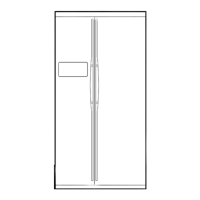Do you have a question about the Samsung SR-S25 and is the answer not in the manual?
Minimizes power consumption via separate air distribution.
Power freezing/refrigerating functions cool food quickly.
Maintains high humidity for extended food freshness.
Three-wavelength lamp for natural food color and easy use.
Alerts when the refrigerator door is open for over two minutes.
Provides continuous supply of ice and cold water.
Easy access to frequently used items without opening main door.
Details the multi-evaporator cycle for efficient cooling.
Precautions against electric shock and fire hazards from plugs/cords.
Warnings against multi-plug adapters, aerosols, and water exposure.
Avoid water containers, damp locations, flammable substances, and disassembly.
Guidelines for safe disposal and proper electrical grounding.
Advice on not overfilling, avoiding glass in freezer, and storing items.
Warnings about loose sockets and improper cord removal.
Precautions regarding children and avoiding frostbite from wet hands.
Warnings about using wet cloths for plugs and handling the unit.
Instructions for power loss and handling abnormal sounds/smells.
Guide on shelf placement and cleaning before first use.
Instructions for initial temperature setting and motor operation.
Guidance on when to store food and compressor operation.
Requirements for sufficient space and a flat installation surface.
Necessity of cleaning the interior and exterior before use.
Importance and method of grounding the refrigerator.
Recommends 5cm spacing for power saving.
Method for adjusting legs to level the refrigerator for easy door operation.
Overview of buttons like Hi-Moist, Door Alarm, Twin Cooling, Deodorizer.
Overview of buttons for DTA/FTA models, including ice functions.
Explanation of FRE. CONTROL and REF. CONTROL buttons.
Function of FRE. QUICK and REF. QUICK buttons.
Light indicates the high humidity function is active.
Explains activation/deactivation of the door alarm.
Light signifies the deodorizer function is operational.
ON light indicates twin cooling system for separate freezing.
Use FRE. QUICK for rapid freezing of food.
Recommended for small amounts of food, sets a warmer temperature.
Suitable for normal usage, offers a medium temperature.
For storing large amounts of food, sets a colder temperature.
Use REF. QUICK for rapid refrigeration.
Best for small food quantities, provides a warmer setting.
Ideal for normal use, maintains a medium temperature.
For poor refrigeration or overfilled sections, sets a colder temp.
Controls for crushed ice, ice cubes, and turning ice off.
Explains the continuous operation of the deodorizer.
Describes the twin cooling system for faster cooling.
Operation of external light and open door alarm.
Notes on automatic shut-off of interior freezer light.
Details the ice maker's output and influencing factors.
How to choose between crushed ice and ice cubes.
Proper cup placement and use with water dispenser.
Advice on ice gathering, size, power failure, and new installation.
Dispenses 6 glasses, requires cooling time between uses.
Recommends discarding first 6 glasses to remove plastic smell.
How to cool warm water by adding ice.
Warnings against disassembly, children playing, and using fragile bowls.
Suitable for frozen foods like ice-cream.
How to store frozen foods on reinforced glass shelves.
For storing small packages of frozen foods.
Storage for meat and dried goods, requires wrapping.
Steps for filling the ice tray with water.
How to properly place the filled ice tray back.
How to release ice into the storage container and avoid issues.
Tips for faster ice production and potential issues.
Suitable for frozen foods like ice-cream.
How to store frozen foods on reinforced glass shelves.
For storing small packages of frozen foods.
Storage for meat and dried goods, requires wrapping.
Safe storage of items on reinforced glass shelves.
Storage for meats/fish for long periods in the freezer section.
Keeps vegetables fresh by maintaining moisture.
Preserves fruit freshness by maintaining moisture.
Note on placing eggs in the egg storage case.
For storing fatty foods like butter and cheese.
For storing small packages like milk and yogurt.
For frequently used items like beverages.
For storing bottles, cans, and cartons.
Instructions for removing reinforced glass shelves.
How to remove multiple guards and door shelves.
Method to remove the storage compartment.
Warning against using excessive force during disassembly.
Steps to remove ice storage and ice containers.
How to remove and reassemble the leg coverage.
Instructions for removing glass shelves in the refrigerator section.
Method to remove the high-humidity chilled compartment.
How to remove the high-humidity vegetable compartment and cover.
How to remove the fruit compartment and cover.
Steps to remove the dry compartment.
How to remove the extra refrigerating compartment.
Method to remove the beverage shelf.
How to open and use the extra compartment for convenience.
Best for frequently used items like beverages, maintains temperature.
Open door can be used as a tray, with cautions.
Notes on door removal, closing, and using the open door.
How to clean interior parts with disinfectant and dry cloth.
Cleaning doors, handles, and polishing the exterior.
Using a vacuum cleaner for dust removal.
Cleaning ice/water dispensers and drainage grid.
How to clean the extra refrigerating compartment.
Importance and method of cleaning door seals.
Precautions for cleaning when the unit is unused.
Step-by-step guide to replacing the freezer lamp.
Instructions for replacing the refrigerator lamp.
What the filter does and how to install it.
Guidance on how often to change the ice-making filter.
Explanation of the filter's chemical filtering and purifying capabilities.
Troubleshooting steps for poor refrigeration performance.
Diagnosing why food in the refrigerator is freezing.
Common noises and their potential causes.
Explains hot corners and dewdrops on the unit.
Troubleshooting steps for when ice is not produced.
Explains sounds and odors within the refrigerator.
Causes of frost in the freezer and dewdrops in the refrigerator.
| Brand | Samsung |
|---|---|
| Model | SR-S25 |
| Category | Refrigerator |
| Language | English |












